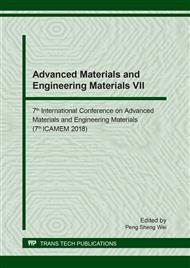[1]
K.P.M. Tang, C.W. Kan, J.T. Fan, Psychological measurement of wet and clingy sensation of fabrics by the volar forearm test, Journal of Sensory Studies. 30 (2015) 329-347.
DOI: 10.1111/joss.12161
Google Scholar
[2]
K.P.M. Tang, C.W. Kan, J.T. Fan, Assessing and predicting the subjective wetness sensation of textiles: subjective and objective evaluation. Textile Research Journal. 85 (2015) 838-849.
DOI: 10.1177/0040517514555799
Google Scholar
[3]
K.P.M. Tang, K.H. Chau, C.W. Kan, J.T. Fan, Characterizing the transplanar and in-plane water transport property of fabrics under different sweat rate: forced flow water transport tester. Scientific Reports. 5 (2015) 17012.
DOI: 10.1038/srep17012
Google Scholar
[4]
K.P.M. Tang, Y.S. Wu, K.H. Chau, C.W. Kan, J.T. Fan, Characterising the transplanar and in-plane water transport of textiles with gravimetric and image analysis technique: spontaneous uptake water transport tester. Scientific Reports. 5 (2015).
DOI: 10.1038/srep09689
Google Scholar
[5]
J. Fan, L. Hunter, Engineering Apparel Fabrics and Garments, Woodhead Publishing Limited, Cambridge, (2009).
Google Scholar
[6]
C.W. Kan, C.M.K. Ko, K. Ariyakruae, R. Mongkholrattanasit, Evaluating the warmth retention ability of polyurethane foam plying with fabrics. The 7th RMUTP International Conference on Science, Technology and Innovation for Sustainable Development. Bangkok, Thailand, 23-24 June (2016).
DOI: 10.4028/www.scientific.net/amm.866.233
Google Scholar
[7]
C.W. Kan, C.M.C. Ko, K. Boontorn, R. Mongkholrattanasit, Characteristics of fabric-foam-fabric plied material – Part I: wetting time, The 7th RMUTP International Conference on Science, Technology and Innovation for Sustainable Development. Bangkok, Thailand, 23-24 June (2016).
DOI: 10.4028/www.scientific.net/amm.866.220
Google Scholar
[8]
C.W. Kan, C.M.C. Ko, P. Jaroensappayanant, R. Mongkholrattanasit, Characteristics of fabric-foam-fabric plied material – Part II: absorption rate, The 7th RMUTP International Conference on Science, Technology and Innovation for Sustainable Development. Bangkok, Thailand, 23-24 June (2016).
DOI: 10.4028/www.scientific.net/msf.932.97
Google Scholar
[9]
C.W. Kan, C.M.C. Ko, N. Sasithorn, R. Mongkholrattanasit, Characteristics of fabric-foam-fabric plied material – Part III: liquid spreading speed, The 7th RMUTP International Conference on Science, Technology and Innovation for Sustainable Development. Bangkok, Thailand, 23-24 June (2016).
DOI: 10.4028/www.scientific.net/kem.772.3
Google Scholar
[10]
C.W. Kan, C.M.K. Ko, W. Changmuang, R. Mongkholrattanasit, Examining the air permeability of polyurethane foam plying with fabrics. The 7th RMUTP International Conference on Science, Technology and Innovation for Sustainable Development. Bangkok, Thailand, 23-24 June (2016).
Google Scholar


